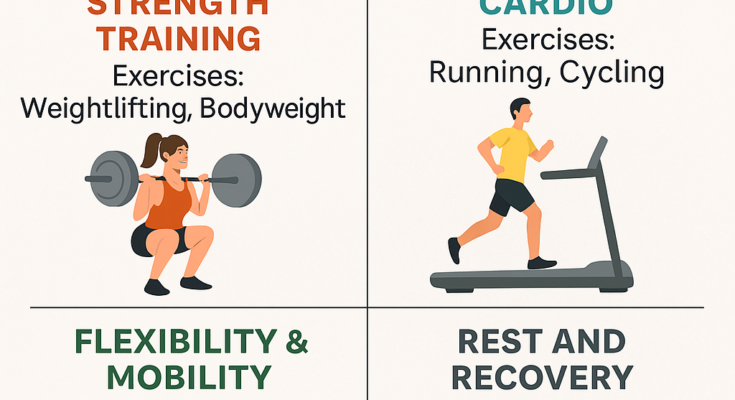Introduction
Creating a balanced fitness routine is essential for achieving long-term health, building strength, improving endurance, and staying injury-free. Whether you’re just starting your fitness journey or you’re a seasoned gym-goer, knowing how to structure your workouts properly can make a world of difference.
In this guide, we’ll walk you through the key components of a well-rounded fitness plan, how to structure your week, and tips for staying consistent and motivated.
1. What Is a Balanced Fitness Routine?
A balanced fitness routine includes a mix of different types of exercise that target various aspects of physical health. The four main components are:
- Cardiovascular training (cardio): Improves heart health and burns calories.
- Strength training: Builds muscle, increases metabolism, and strengthens bones.
- Flexibility and mobility: Enhances range of motion, prevents injuries, and aids recovery.
- Rest and recovery: Essential for muscle repair and overall performance.
2. The 4 Key Components Explained
A. Cardiovascular Training
Examples: Running, cycling, swimming, jump rope, HIIT
Cardio workouts strengthen your heart, boost endurance, and help with fat loss. Aim for at least 150 minutes of moderate-intensity or 75 minutes of high-intensity cardio per week.
Tip: Mix steady-state cardio with interval training for best results.
B. Strength Training
Examples: Weightlifting, resistance bands, bodyweight exercises
Strength training not only builds muscle but also boosts metabolism and improves bone density. Target major muscle groups 2–3 times per week with at least 48 hours of rest between sessions.
Tip: Alternate between upper body and lower body days or use full-body routines.
C. Flexibility & Mobility
Examples: Yoga, dynamic stretching, foam rolling
Flexibility training improves posture, reduces muscle tension, and lowers injury risk. Incorporate stretching after workouts and dedicate at least 1–2 sessions per week to mobility work.
Tip: Use foam rolling or a massage gun to enhance recovery and reduce soreness.
D. Rest and Recovery
Rest days are crucial for allowing your muscles to rebuild and grow. Without proper rest, your body becomes more prone to fatigue and injury.
Tip: Schedule at least 1–2 full rest days per week, and consider light active recovery like walking or gentle yoga.
3. Weekly Fitness Schedule Example
Here’s a sample weekly plan for a balanced fitness routine:
| Day | Focus |
|---|---|
| Monday | Strength (Full Body) |
| Tuesday | Cardio (HIIT) + Stretching |
| Wednesday | Strength (Upper Body) |
| Thursday | Active Recovery (Yoga or Walk) |
| Friday | Strength (Lower Body) |
| Saturday | Cardio (Steady State) |
| Sunday | Rest |
4. Tips to Stay Consistent
- Set realistic goals: Know what you want to achieve—fat loss, muscle gain, or general health.
- Track your progress: Use a fitness journal or app to log workouts.
- Listen to your body: Rest when needed and avoid overtraining.
- Stay motivated: Switch up your routine to keep things fresh and fun.
5. Customize It to Your Needs
Your routine should fit your lifestyle, goals, and fitness level. Beginners might start with 3–4 sessions per week, while advanced individuals may work out 5–6 times weekly. The key is balance—don’t neglect any component of fitness.
Final Thoughts
A balanced fitness routine isn’t just about working hard—it’s about working smart. By including strength, cardio, flexibility, and rest in your weekly schedule, you’ll build a healthier, stronger, and more resilient body.
Start small, stay consistent, and remember: progress is better than perfection!



